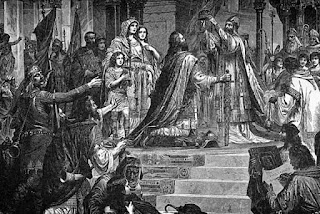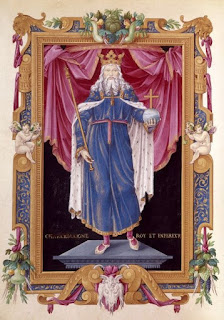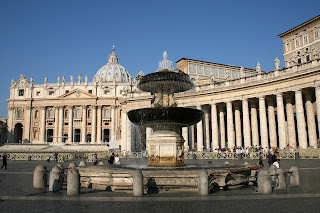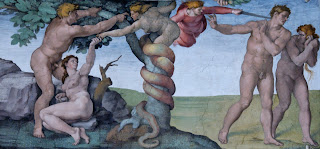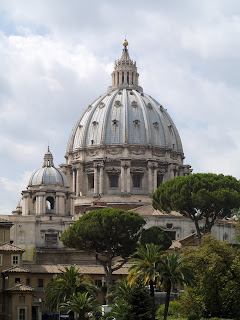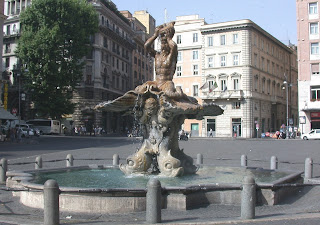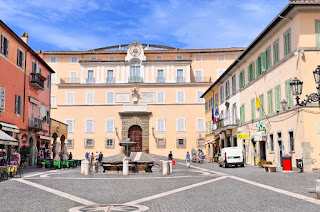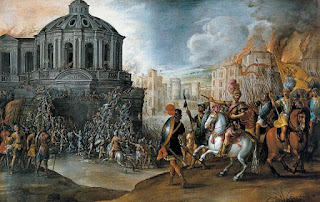Artist best known for Oceanus statue at Trevi Fountain
 |
| Pietro Bracci's statue, Oceanus, is the centrepiece of the Trevi Fountain in Rome |
The monumental figure is shown standing on a chariot, in the form of a shell, pulled by two winged horses flanked by two tritons. Bracci worked from sketches by Giovanni Battista Maini, who died before he could execute the project.
He also completed work on the fountain itself, built in front of Luigi Vanvitelli’s Palazzo Poli. This was started by Bracci’s close friend Nicola Salvi, who had been commissioned by Pope Clement XII to realize plans drawn up by Gian Lorenzo Bernini that had been shelved in the previous century. Salvi died in 1751, before he could complete the work. Giuseppe Pannini was also involved for a while before Bracci took over in 1761.
The work confirmed Bracci as a major talent of his time in the field of sculpture, one of the greatest of the late Baroque period, continuing in the tradition established by Bernini in the previous century that gave the city of Rome so many wonderful monuments.
Bracci’s most significant works in addition to the Trevi are considered to be four monumental tombstones, two of which are in St Peter’s Basilica.
 |
| The monumental tomb of Maria Clementina Sobieski in St Peter's Basilica |
Bracci also sculpted the figures for the tomb of Benedict XIII (1734) in Santa Maria sopra Minerva, Rome, which was designed by the architect Carlo Marchionni, and for the tomb of Benedict XIV (1763–1770) in St Peter’s Basilica, completed with the help of his pupil Gaspare Sibilia, as well as the polychromatic tomb of Cardinal Giuseppe Renato Imperiali (1741) in Sant'Agostino in Rome.
The son of a wood sculptor, Bracci was an apprentice in the workshop of the sculptor Camillo Rusconi for six years. He became a member of L’Accademia dell’Arcadia in Rome and of L’Accademia di San Luca and opened his own workshop in the Piazza Trinità dei Monti in 1725.
He married Faustina Mancini, the daughter of the painter Francesco Mancini. They had a son, Virginio, who grew up to be a sculptor and architect, who was heavily involved with the construction of the town of Servigliano in the Marche, and gave much help and advice to the young Antonio Canova.
Bracci died in Rome in Rome in 1773 and was buried in the Pantheon, where his son had commissioned a bust of his father by Vincenzo Pacetti.
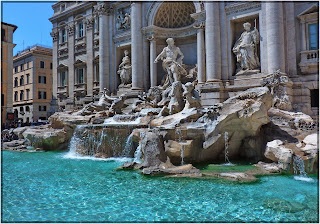 |
| The Trevi Fountain stands in front of the Palazzo Poli. It is one of Rome's most visited tourist sites. |
The Trevi Fountain takes its name from its location in the Trevi district of Rome. An earlier fountain on the site was demolished in the 17th century. Nicola Salvi’s design was chosen after entries were invited to a competition. The idea of incorporating the fountain as part of the front of the Palazzo Poli came from a project by Pietro da Cortona, but the central triumphal arch with its mythological and allegorical figures, natural rock formations, and gushing water was Salvi’s idea. The immense fountain stands some 85 ft (26m) high and is approximately 160 ft (49m) wide. Its water, from the ancient aqueduct called Acqua Vergine, was long considered Rome’s softest and best tasting. The water today is not considered fit for drinking. The coins that are thrown into the fountain are collected daily and donated to charity.
 |
| The Piazza di Spagna and the Via Condotti seen from the Piazza Trinità dei Monti, above the Spanish Steps |
The Piazza Trinità dei Monti, where Bracci opened his first workshop, is a square in central Rome adjoining the Renaissance church of the Santissima Trinità dei Monti, at the top of the Scalinata di Trinità dei Monti, better known as the Spanish Steps. During Springtime, just before the anniversary of the foundation of Rome, April 21, part of the steps are covered by pots of azaleas. Recently, the Spanish Steps have included a small cut-flower market. The steps are not a place for eating lunch, being forbidden by Roman urban regulations, but they are usually crowded with people.
More reading:
How Nicola Salvi's designs were chosen for the Trevi Fountain
Gian Lorenzo Bernini - the architect, more than any, who conceived the look of Rome
The consecration of St Peter's Basilica
Also on this day:
1942: The birth of 15-times world motorcycling champion Giacomo Agostini
2008: The death of Mario Rigoni Stern, war hero who became bestselling novelist
Home
